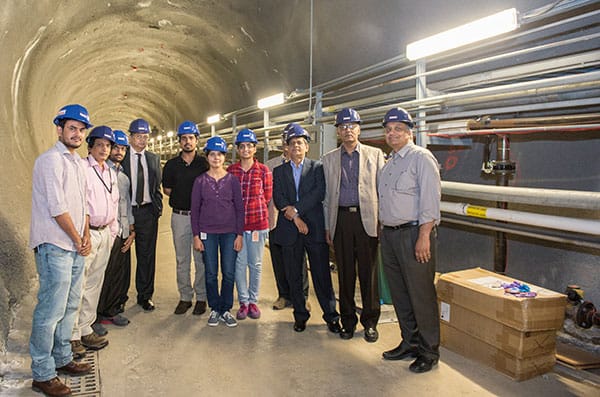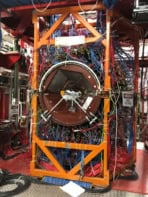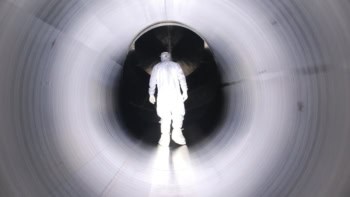While India has been participating in international particle-physics collaborations for many years, challenges remain before it can become a major player, as T V Padma reports

Particle physicists in India have had much to cheer about since 2012. Not only could they take some of the credit for having helped to discover the Higgs boson at the CERN particle-physics lab near Geneva, but also the discovery spilled over from the confines of department coffee rooms to newsrooms around the country. The resulting TV and press bulletins clearly pointed to the enormous contributions that Indian physicists from both national research institutes and universities had played in one of the biggest discoveries in particle physics in recent memory – a finding that led to François Englert and Peter Higgs being awarded the 2013 Nobel Prize for Physics.
India’s Department of Atomic Energy entered into an agreement with CERN in 1991 to participate in the lab. Since 2002, India has had “observer” status at CERN and contributes towards many aspects of the lab, including the design of the detectors at the Large Hadron Collider (LHC) – including CMS and ATLAS – as well as the software that is used to monitor and analyse data. Indeed, those efforts will be all the more important given that CERN will begin to hunt for particles beyond the Standard Model of particle physics when the LHC starts up again in mid-2015. It is expected that the LHC will then be accelerating and colliding protons with an energy of about 6.5 TeV – near the LHC’s 7 TeV design energy. “For the past 40 years, international collaboration in particle physics has always been our strength,” says particle physicist Atul Gurtu of the Tata Institute of Fundamental Research (TIFR) in Mumbai, who is a former spokesperson for the LHC’s CMS experiment.
Still miles to go
With an economy that was expanding by around 10% a year, the Indian government recognized that more scientists and engineers were needed to sustain the continued development of science. So in 2008 the then Prime Minister Manmohan Singh announced that the government would set up eight new Indian Institutes of Technology (IIT) to build on the country’s five existing IITs. Singh also announced the new Indian Institute of Science Education and Research, as well as plans to fund 30 new central universities.
While these initiatives will take time to have an effect, most scientists in India agree that the country has done exceedingly well in theoretical particle physics, but needs to improve its performance in experimental particle physics before the country can emerge as a top player in the field. India’s weaknesses include a lack of financial clout as well as a lack of technological expertise to do the necessary hardware and instrumentation R&D. “We do not have that many financial resources as well as the necessary number of trained scientists to participate in diverse international projects,” says Gurtu. “That is now biting us.”
Sunanda Banerjee from the Saha Institute of Nuclear Physics in Kolkata heads a 22-member group that works at the LHC. The team is involved with CMS, monitoring the performance of its hadron calorimeter, which measures the energies of elementary particles that are produced during the collisions. Banerjee’s team is also involved in constructing the electronics for a planned upgrade to the hadron calorimeter and tracking system.
Although particle physicists in India have gained recognition for their work in software, Banerjee says that the credit for that mostly goes to the efforts of individual physicists rather than “concerted institutional efforts in the sector”. Another area of struggle is specifically in acquiring the know-how to build particle detectors. “We are good in following well-established techniques in making a detector, but we are far away from making a detector of novel design,” adds Banerjee, who is also a member of the Geant4 team – an international collaboration with scientists from CERN, Fermilab and other key international labs – that is developing a software toolkit to track particles.
One reason why India is struggling in these areas could be because the country does not have an indigenous high-energy particle accelerator of its own. “In India, we don’t have an accelerator that can provide even 1 GeV centre-of-mass energy,” says CERN-based physicist Archana Sharma. “We need to learn from CERN how to design high-current, high-energy accelerators.” Sharma adds that even if India did build a new particle collider, it would also need to develop much more expertise in electronics design and microchip development.
That view is backed by physicist Jasbir Singh from Panjab University. “In experimental particle physics, most faculty members and students are involved in data analysis and software development, but participation in detector development, especially making detectors for big projects is lacking,” says Singh. “Most Indian universities do not create facilities to strengthen the experimental base.”
Chasing China
While India has not yet been able to reach a level competitive with that of Europe, the US or Japan, some physicists in India think that the country has slipped behind China – its long-time rival since the mid-1970s. China has been developing the necessary technology for accelerators such as high-vacuum systems, fast electronics and precision-guided waveguides as well as sending hundreds of young physicists to labs abroad to learn.
“China is doing better than India when it comes to taking on big projects domestically,” says Rohini Godbole of the Indian Institute of Science’s Centre for High Energy Physics in Bangalore. Singh agrees that China is doing well in detector development adding that some aspects of Chinese development such as accelerator technology is “on par with the West”.
While many say that India needs to provide much greater investment to train scientists and develop the necessary technology so that it can compete globally, it is not all doom and gloom for India’s particle physicists. Fermilab director Nigel Lockyer says that in some areas, such as the design of cyclotron accelerators, India is “neck and neck with other countries”. Lockyer predicts that India will be a leading nation in particle physics in the coming decade, even with competition from China, thanks to India’s national commitment to science, from training in schools and universities to advanced research institutes.
“This gives India a significant advantage compared with its peers, as evidenced by its early and significant participation in the software and computing industries,” says Lockyer. “With these successes, India has the chance to continue to lead through focused commitment to national science facilities such as observatories, accelerators and new laboratories.”
Towards the forefront of neutrino physics

It is not just CERN where India has a focus on particle physics but also at Fermilab near Chicago in the US. A number of Indian institutes, including the Bhabha Atomic Research Centre in Mumbai, Raja Ramanna Centre for Advanced Technology in Indore and the Variable Energy Cyclotron Centre in Kolkata, are involved in developing the technology for accelerators based on superconducting magnets. The country’s universities are also making their presence felt too. Physicists at Panjab University in Chandigarh, for example, contributed towards the construction of the Tevatron’s now-defunct DZero detector as well as the Bubble Chamber Detector Neutrino Experiment.
Physicists at Panjab are now involved in the planned Long Baseline Neutrino Experiment (LBNE), which will study neutrino mass and interactions when it is switched on in the coming decade. They are involved in the integration and construction of one of the LBNE’s two main detectors – the “near” neutrino detector that will be placed right at the neutrino beam at Fermilab. (The second detector – the far neutrino detector – lies 800 km away from the Chicago lab.)



